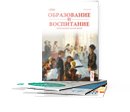This study investigates how to improve vocabulary knowledge among Kazakh secondary students by using both top-down and bottom-up educational approaches. A key element of language learning is expanding one's vocabulary, and the success of students can be greatly impacted by the efficacy of various teaching methods. The top-down method stresses the use of context and prior information to infer word meanings, whereas the bottom-up method concentrates on the examination of individual word components, such as phonemes, morphemes, and spelling rules. This examination of the literature looks at the theoretical underpinnings of these strategies, how they are used in the Kazakh educational system, and the advantages and disadvantages of each. The possible benefits of integrating both strategies into a hybrid model—which would offer a more thorough framework for vocabulary development—are also covered. The review comes to the conclusion that an integrated strategy works especially well for Kazakh secondary pupils because it combines the contextual fluency of top-down techniques with the technical accuracy of bottom-up strategies. To assess the useful results of this integrated approach in actual classroom environments, more research is advised
Keywords: vocabulary, bottom-up, top-down, benefits, drawbacks.
Introduction
In non-native language situations like Kazakhstan, where students are frequently learning English or other languages, expanding one's vocabulary is essential to language acquisition. Developing techniques to understand and utilize words in a variety of settings is just as important as memorizing terms for a thorough vocabulary. This evaluation of the literature investigates how well two popular teaching strategies—bottom-up and top-down—work to improve Kazakh secondary students' vocabulary. The review covers the theoretical foundations of these methods, how they are used in language acquisition, and the advantages and difficulties they pose for Kazakh language learners.
Because it has a direct impact on understanding, communication, and academic success, vocabulary development is an essential component of language acquisition. Because they have to acquire a new language's structure and context, learning English or other foreign languages can be very difficult for Kazakh secondary pupils. The way that vocabulary is taught has a big impact on how well students remember and use new words. The two teaching approaches—bottom-up and top-down approaches—and their use in enhancing Kazakh secondary students' vocabulary knowledge are the main topics of this literature review. The purpose of these tactics is to help students learn vocabulary by emphasizing either the overall context (top-down) or individual word components (bottom-up).
Literature review
Understanding the individual parts of language, such as phonemes, morphemes, and syllables, in order to generate meaning, is the main goal of the bottom-up method to vocabulary acquisition. This method concentrates on more detailed language processing and is closely tied to the idea of decoding in reading. The importance of phonological, orthographic, and morphological awareness is emphasized in bottom-up training. Learners who can correctly decode words are better able to comprehend them in context, claims Snow (2010). Furthermore, according to Nation (2001), a strong foundation in word identification and word part knowledge improves a learner's capacity to gradually increase their vocabulary. Students can identify and retain new words more effectively because to this technique.
Top-down approaches can be especially helpful for Kazakh learners of English in deducing meanings from context. Kaliyeva (2018) claims that because Kazakh pupils are multilingual, they frequently have access to a wealth of linguistic and cultural context, which facilitates their ability to make informed estimates about word meanings.
Such settings, such as reading comprehension exercises and real-world application, can be included into top-down tactics that greatly improve vocabulary learning and retention. Because it promotes deeper cognitive engagement, the top-down strategy has the advantage of assisting learners in strengthening the linkages between words and their meanings. It could be difficult for students who don't have enough background knowledge or language abilities, though, particularly when context hints aren't immediately obvious.
Although both top-down and bottom-up strategy has advantages of its own, new research indicates that the best vocabulary development outcomes may come from a complementing combination of the two methods. Anderson (2012) contends that the best results in language learning come from a balanced strategy that incorporates both top-down and bottom-up tactics. This hybrid approach enables students to acquire word-level information and context-inferred meanings at the same time. By combining these methods, learners' varied needs are met by guaranteeing a solid foundation in word recognition and encouraging the application of context and prior knowledge.
A multilingual and multicultural learning environment may make a blended instructional method particularly advantageous in Kazakhstan. Mukhtarova (2020), for example, highlights that Kazakh pupils could improve their comprehension by first learning a word's structure (bottom-up) and then using this information in context (top-down). Both linguistic precision and interpretative skills can be developed in kids through classroom activities that integrate both methodologies, such as interactive reading, word games, and peer conversations. When bottom-up and top-down methods are combined, learners are guaranteed to be able to use words in a variety of real-world contexts in addition to being able to recognize and comprehend them at the micro level.
Finding the ideal balance between the two strategies is difficult, though, in order to prevent overburdening kids or ignoring either crucial element. Additionally, educators must be skilled in evaluating students' capacity to switch between these two approaches with ease. Vocabulary training is significantly impacted by the complexity of language acquisition in Kazakhstan's multilingual society. Both top-down and bottom-up approaches can be used by teachers to help students learn English vocabulary. A number of variables, including the students' level of skill, their linguistic and cultural background, and the environment in which the language is being used, affect how effective these methods are. It is crucial to create curriculum that give students the chance to interact with vocabulary in context (via reading, speaking, and listening exercises, for example) as well as at the word level (through spelling and morphology). To improve language learning in Kazakh secondary schools, class plans that prioritize vocabulary acquisition through both scheduled and unstructured activities should be developed. Effective integration of these tactics requires training for teachers. The ability to scaffold vocabulary learning so that pupils may transition between contextual inference and decoding is one example of this. It is imperative that professional development opportunities and workshops emphasize the application of both techniques in language training.
Theoretical Underpinnings of the Bottom-Up Approach to Word Recognition and Decoding: The foundation of the bottom-up approach is decoding, which is the process of dissecting words into their constituent sounds or syllables (Gough & Tunmer, 1986). Strong word identification abilities that enable proper vocabulary comprehension and usage are the aim for pupils. Morphemic Awareness: According to Bowers & Kirby (2010), vocabulary growth revolves around an awareness of morphemes, which are a language's smallest units of meaning. The bottom-up method fosters deeper knowledge by assisting students in dissecting words into their root forms and affixes.
Benefits: The bottom-up method works well for developing accurate decoding abilities, which are necessary for learning challenging words. This approach strengthens the language structures that students come across in texts and aids in the micro-level retention of vocabulary. Snow (2010) Problems: Although bottom-up approaches are useful for word recognition, they frequently don't focus on how to employ language in real-world situations. As a result, pupils may be able to identify vocabulary but find it difficult to use them effectively in conversation (Nation, 2001).
The top-down method places emphasis on first comprehending language from the «big picture» or context, and then dissecting the specifics. Learners don't just concentrate on word structures; they also draw meanings from context and use prior knowledge.
Foundational Ideas of Top-Down Approach Schema Theory: According to Anderson & Pearson (1984), schema theory holds that students understand new information by drawing on their prior experiences and knowledge. This makes it possible for students to deduce the meanings of new words from their context. Cognitive Models The top-down method is supported by Vygotsky's (1978) sociocultural theory, which highlights the significance of social context and interaction in learning. Learners interpret new words by using their surroundings, social interactions, and contextual signals.
Kaliyeva (2012) suggests that top-down strategies can benefit Kazakh learners by using the cross-linguistic similarities between Kazakh, Russian, and English in making context-based guesses about new vocabulary. Benefits and Limitations Benefits: The top-down approach encourages deeper cognitive engagement and supports the learner's ability to use language fluently in communication. This method is useful for vocabulary retention because it links new words to students' prior knowledge and real-world contexts. Having been exposed to multiple languages, Kazakh students frequently possess rich cultural and contextual knowledge, which can be leveraged in top-down strategies, where students infer word meanings based on the context of reading passages, conversations, or multimedia content.
A thorough method for vocabulary acquisition is provided by combining top-down and bottom-up approaches. Combining these methods enables students to not only decipher words but also successfully apply them in conversation, according to Anderson (2008). This hybrid approach promotes both the technical understanding of word forms and the useful contextual application of vocabulary. An integrated method can offer the combined advantages of fostering learners' meaningful use of new vocabulary and enhancing their word-level knowledge in Kazakhstan, where language training frequently entails striking a balance between native and foreign languages. Teachers can use context-rich activities, such as reading comprehension exercises that call for contextual inference in addition to word identification, to introduce vocabulary (Mukhtarova, 2020).
Conclusion
Both top-down and bottom-up methods are supported by the research for vocabulary growth, and each has special benefits. For Kazakh secondary students, the best vocabulary training may come from a well-rounded strategy that incorporates both tactics. In diverse, multilingual situations like Kazakhstan, further research is required to examine the precise results of these methods and their effects on long-term language proficiency. In Kazakh secondary schools, vocabulary development through the application of top-down and bottom-up teaching methodologies provides beneficial avenues for improving language acquisition. While top-down tactics enable learners to interact meaningfully with vocabulary in context, bottom-up approaches help students recognize and comprehend words.
In order to convey their ideas and meanings to the passive learner, teachers act as conduits. There is not much opportunity for students to think independently, ask questions, or engage with one another. Repeating mechanically the teacher's recognized explanation or methodology is the learner's aim. Speaking, listening, reading, and writing are the four language skills that are covered in English as a foreign language instruction. Students must possess a collection of English words in order to grasp these abilities. Put another way, if they have a large vocabulary, it will be easier for them to write, speak, and comprehend reading texts in English. Consequently, it is believed that vocabulary is a fundamental component in the development of the four language abilities. Learning vocabulary is crucial to learning a language. It should be acknowledged as a key component of language training from the outset in order to effectively develop such abilities. It is hard for children to use a language if they do not have a strong vocabulary. However, if they have, they will be able to quickly and accurately discern the meaning of most terms. However, gaining vocabulary enables kids to speak English and makes them eager to read books written in plain English. One may argue that learning vocabulary is an excellent place to start when trying to improve your English. Knowledge of words and their meanings is the general definition of vocabulary.
References:
- Quiroz, B. G., Snow, C. E., & Zhao, J. (2010). Vocabulary skills of Spanish—English bilinguals: impact of mother—child language interactions and home language and literacy support. International Journal of Bilingualism, 14(4), 379–399.
- Nation, I. S., & Nation, I. S. P. (2001). Learning vocabulary in another language (Vol. 10, pp. 126–132). Cambridge: Cambridge university press.
- Kaliyeva, A. B., & Alkeyeva, D. S. (2019). The importance of trilingual system in Kazakhstan. In Colloquium-journal (No. 9 (33), pp. 101–102). Голопристанський міськрайонний центр зайнятості.
- Anderson, C. J. (2012). Utilizing student-generated pictures for formative vocabulary instruction. Vocabulary Learning and Instruction, 1(1), 37–43.
- Mukhtarova, T. (2020). COVID-19 and the Informal Sector.
- Gough, P. B., & Tunmer, W. E. (1986). Decoding, reading, and reading disability. Remedial and special education, 7(1), 6–10.
- Bowers, P. N., & Kirby, J. R. (2010). Effects of morphological instruction on vocabulary acquisition. Reading and writing, 23, 515–537.
- Vygotsky, L. S. (1978). Mind in society: The development of higher psychological processes (Vol. 86). Harvard university press.
- Anderson, T. (2008). The theory and practice of online learning. Athabasca University.







